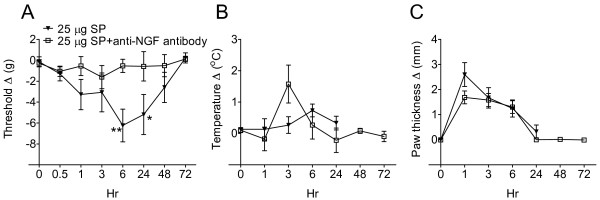Figure 6.
This experiment tested the hypothesis that the delayed onset, long lasting allodynia evoked by intraplantar injection of substance P (SP) was mediated by increased nerve growth factor (NGF) expression in skin keratinocytes. Rats (n = 8 per cohort) were treated with either anti-NGF antibody (10 mg/kg i.p. muMab 911) or vehicle, 3 days prior to undergoing intraplantar SP (25 μg) injection. (A) SP injection induced a slowly developing von Frey allodynia that peaked at 6 h post-injection, but SP-induced allodynia was blocked by pretreatment with anti-NGF. (B) There were no changes in hindpaw temperature after injecting SP. (C) Anti-NGF pretreatment had no effect on SP-evoked hindpaw edema. Measurements for (A), (B), and (C) represent the difference between the injected side and the contralateral paw, thus a positive value represents an increase in temperature or paw thickness on the injected side; a negative value represents a decrease in mechanical nociceptive thresholds on the injected side. Behavioral data after SP injection were analyzed by two-way analysis of variance (ANOVA) followed by Bonferroni post hoc test to compare differences between rats pretreated with and without anti-NGF antibody at indicated time points. *P < 0.05 and **P < 0.01 vehicle vs. anti-NGF antibody pretreatments.

